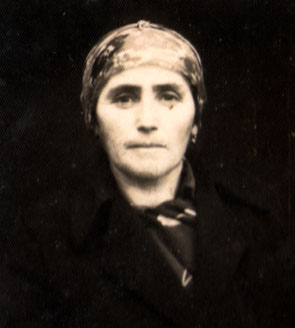Hendl Katz
My mother, Hendl Katz. This photo was taken in Korolevo in 1930.
My mother was born in 1904 in Korolevo, Khust district, in Subcarpathia. My parents knew each other since childhood. They lived in the same street. When they grew up they decided to get married. They had a traditional Jewish wedding with a rabbi and a chuppah. I think they got married in 1924 or at the beginning of 1925. At that time this was the only possible way of getting married. I don’t know if they had a civilian marriage too. At that time many Jewish families in Subcarpathia had a traditional wedding and a marriage registry note in the synagogue register.
When my older sister and I grew big enough my mother sent us to cow owners. We had buckets and the housewives milked their cows using our buckets. Not all of them were Jewish families and my mother preferred to have them use our containers to keep this milk kosher. I went to one end of the village and my sister went to the other. We brought the milk home and my mother made sour cream, butter, custard and cheese from it.
Twice a week my mother took her dairy products in two baskets to Khust where she had her Jewish clients. She walked 8 kilometers to Khust and 8 kilometers back home with heavy loads. For the money her clients paid my mother paid for the milk and bought us bagels in Khust. We were so happy about them! Our parents spent the money they earned to buy food for the family and horses.
We grew potatoes, corn and beans in the field that my mother had received as dowry from my grandfather. We all worked a lot in the field. I was the oldest son and helped my mother a lot. My mother carried the youngest child wrapped in a blanket to the field and the other children carried spades and hoes.
My mother lay the youngest child down in the bushes and worked with us. When the child cried my mother ran to change diapers and feed the baby and returned to work. We worked until dark and then returned home. We all knew that what we harvested would be our food for the winter. This was the way we lived: we didn’t starve, but we only had sufficient to live on.
